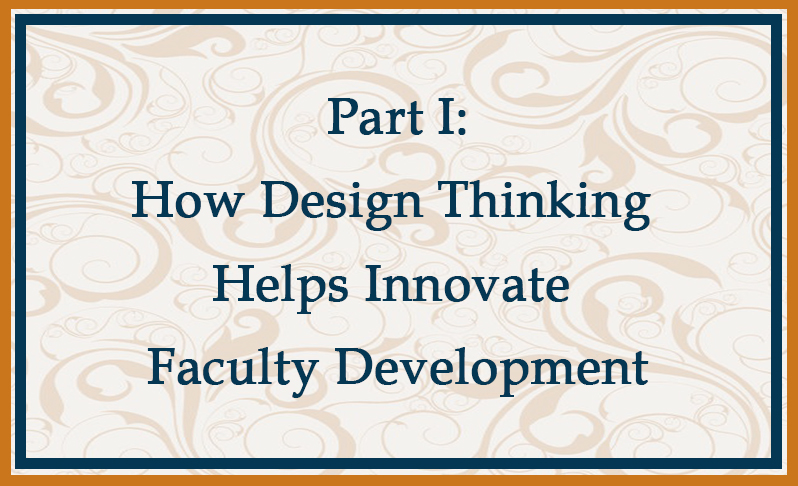Throughout the years in our center for teaching & learning (CTL), we’ve pretty much relied on our own approach to creative thinking, something we’ve discussed in these posts but really detailed in Introduction to Applied Creative Thinking (2012) and Teaching Applied Creative Thinking (2013). Recently, to help guide us through numerous projects, we’ve been using another form of creative thinking called Design Thinking, adapting it to suit our purposes. Beginning as a business approach, design thinking has found its way into education from K-12 to higher ed, and it’s a process you might want to look into.
Design Thinking Defined
According to Tim Brown, CEO and president of IDEO (an innovation and design firm), design thinking is “a methodology that imbues the full spectrum of innovation activities with a human-centered design ethos. By this, I mean innovation is powered by a thorough understanding, through direct observation of what people want and need in their lives and what they like or dislike about the way particular products are made, packaged, marketed, sold, and supported” (p. 86). As professional developers, what interested us most is Brown’s proclamation that “innovation’s terrain is expanding. Its objectives are no longer just physical products; they are new sorts of processes, services, IT-powered interactions, entertainments, and ways of communicating and collaborating” (p. 86).
At its foundation design thinking is a transferrable process. Depending on your source, design thinking has various stages:
- Seven Stage: define, research, ideate, prototype, choose, implement, and learn
- Five Stage: Redefining the problem, need-finding and benchmarking, ideating, building, and testing
- Stanford dschool: empathize, define, ideate (brainstorm), prototype, test (seeking feedback)—acronymically EDIPT
- Brown’s Three-Space/Three I Approach: inspiration, ideation, and implementation.
Related Reading: Introduction to Applied Creative Thinking
Why Design Thinking
O.K., you’re thinking, but why do we need design thinking? Can’t we just use our traditional approaches, such as SWOT (Strengths, Weaknesses, Opportunities, and Threats) analysis, or rational problem-solving?
First, some situations manifest what Rittel (1973) refers to as wicked problems wherein it’s difficult to discern the problem much less the solution. Such situations are not wicked in the sense of evil, but rather an ill-defined rat’s nest.
Second, traditional rational analysis does not necessarily begin with the human-centeredness of the problem. In academia students and faculty take center stage in our deliberations.
Third, rational problem-solving techniques are not necessarily collaborative, whereas design thinking depends upon a group. Collaborations increase ideation levels and provide multiple perspectives on the same situation being studied.
Four, rational problem-solving tends to be linear, whereas design thinking encourages recursiveness. As Brown explains about the three spaces—inspiration, ideation, and implementation—“Projects will loop back through these spaces—particularly the first two—more than once as ideas are refined and new directions taken” (p. 89).
Reated Reading: How to Provide Faculty Innovation Despite Professional Gaffes
Five, design thinking is fun. It focuses on a human-centered situation, and it employs a human-centered approach to deal with the situation. Therefore, design thinking satisfies the humans involved in the situation as well as those of the group examining the situation. Brown believes that “Often the emotional connection to a product or an image is what engages us in the first place” (p. 92). In A Whole New Mind (2008) Pink labelled this concept “high touch.”
Sixth, proper implementation of design thinking often provides not one solution (per rational analysis) but several. All solutions can be tried, and not every one will be successful or the proper fit for each individual.
Seven, design thinking is applicable to many situations, and, most importantly, it’s not just reserved for business.
Conclusion
Design thinking is a sort of intellectual Leatherman tool that can be applied to higher education in many ways, and here are some:
- Curricula redesign
- A curriculum in itself
- Ascertaining the role of evolving technologies
- Examining learning space
- Problem-solving of any subject
- An alternative to the right-wrong constriction of student learning often found in testing.
Does design thinking have limitations? Certainly users must be trained. Users must get beyond the K-12 bubble-in testing mentality. Some problems can be reduced to the algebraic x=?. And not everyone is comfortable using such an approach.
Next time we’ll take you through some instances where we have practiced design thinking, breaking the process down to its stages and using very real examples.
Author
 Charlie Sweet is currently Co-Director of the Teaching & Learning Center (2007+) at Eastern Kentucky University. Before going over to the dark side of administration, for 37 years he taught American Lit and Creative Writing in EKU’s Department of English & Theatre, where he also served as chair (2003-2006). Collabo-writing with Hal Blythe, he has published well over 1000 items, including 15 books; of his 11 books with New Forums. Meet Charlie.
Charlie Sweet is currently Co-Director of the Teaching & Learning Center (2007+) at Eastern Kentucky University. Before going over to the dark side of administration, for 37 years he taught American Lit and Creative Writing in EKU’s Department of English & Theatre, where he also served as chair (2003-2006). Collabo-writing with Hal Blythe, he has published well over 1000 items, including 15 books; of his 11 books with New Forums. Meet Charlie.



